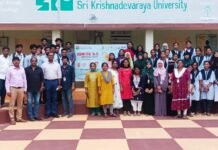New Delhi, Delhi, India | 29th January 2021: While India has been making progress towards achieving Sustainable Development Goals (SDGs), the COVID-19 pandemic has exacerbated the existing inequalities among vulnerable populations — with children being affected the most. Children, who comprise 40 per cent of India’s population, have been severely affected in terms of their education, health and protection. Children have been pushed further into poverty as parents have lost income sources[1], and are faced with reduced access to health, nutrition, education and protection services.
Health & Nutrition:In the 2021 Budget, there is an urgent need to increase public funding on health to 2.5% GDP and invest proportionately in Public Health and Primary Health care. To facilitate achieving universalization of health services there needs to be a target of reducing households facing catastrophic health expenditure by 25%, by 2025.[2]
Children are susceptible to infections with high risks of mortality and morbidity especially with COVID-19 and to reduce out of pocket expenditure for vulnerable families, there is need enhance Janani Shishu Suraksha Karyakaram entitlements for children up to 2 yearsfrom 1 year. There also needs to a benchmark nutrition spending to a minimum of Rs 38,571 crores[3] to fully finance core Direct Nutrition Interventions under ICDS (Integrated Child Development Services) and NHM (National Health Mission). To ensure maximum coverage and effective budget planning, findings[4] suggest determination of local state-wise unit cost.
It is strongly recommended to expedite and prioritize expansion of Pneumococcal Vaccine (PCV) for children in full national immunization schedule and inclusion in all states. Also, the country’s health infrastructure, more so in the wake of pandemic, revealed a need to enhance resources for strengthening oxygen infrastructure. With the introduction of improved oxygen sources and regular capacity building[5], India could combat childhood pneumonia.
The Union Budget needs to see an increase in WASH[6] (Water Sanitation and Hygiene) allocation under Swachh Bharat Mission (rural and urban)at schools, AWCs (Aanganwadi Centers) and health centres and maintain budget provision to AMRUT (Atal Mission for Rejuvenation and Urban Transformation), NULM[7] (National Urban Livelihoods Mission) & Smart Cities Mission for children under-five.
Education:
- Increase public funding on education to 6% GDP as mandated by NEP (National Education Policy) 2020 with a clear financial plan.
- Include COVID-19 sub-plan to ensure safe return of children with dedicated allocations on WASH, additional classrooms and staffing in both schools and AWCs.
- Enhance Samagra Shiksha Abhiyan (SMSA) allocations to ensure learning continuity and equitable digital access for 247 million children[8] affected by COVID-19.
- Increase SMSA allocation for teacher capacity-building and training to include psychosocial care and other needs of the crisis as only 2% SMSA allocations is for teachers’ education.[9]
- Increase Early Childhood Care & Education (ECCE) share to more than 1.4% total government expenditure as stated in NEP as States are currently struggling with severe revenue shortfall.
- Separate budget line item for curriculum development and building capacities of ECCE providers (as per ECCE Policy).
Child Protection:
- Increase public funding for Child Protection Services to 1.5% GDP. To strengthen and capacitate existing mechanisms, set up a dedicated division in NIPCCD[10] (National Institute of Public Cooperation and Child Development) on training with focus on psychological support and a systemic Competency-Based Training.
- Increase allocation for Integrated Child Protection Scheme (ICPS). Enhanced allocation is needed under Sponsorships with renewed District Needs Analysis to prepare District Child Protection Plan. The meagre allocation of Rs. 2160/- per child per month should be increased to improve quality in Child Care Institutions.
- Increase allocations to adapt and strengthen Childline and women helpline for increased domestic violence incidences in COVID-19 context[11]. With provision of safety measures (PPE Kits) and provision for Integrated Command Control Centre (ICCC).
- Budgetary provision for setting up designated fast track special court (FTSC) in each district for POCSO cases (Prevention of children from Sexual Offences) to Rs. 767.26 crores from current share of Rs. 474 crore to enable provisioning of 1023 FTSC courts required in 389 districts for disposal of 166,882 rape and POSCO cases across India.
- Enhance budget for setting up Anti Human Trafficking Unit and Women Help Desks to Rs. 150 crore from Rs. 100 crore for coverage across 764 police districts in India.
- Enhance budget on National Child Labour Project (NCLP) to streamline SOP on CALPRA and PENCIL portal to prevent and rehabilitate child labour.
- Allocate resources for nationwide operationalization of SOP for Care and Protection of Street Children, by NCPCR and Save the Children[12] and increase allocation to Pradhan Mantri Awas Yojana (Urban) to include homeless and street children[13]
Poverty & Inclusion:
- Create fiscal space towards investing 1% GDP towards child-focused social protection measures & benefits specifically :
- Integrated Nutrition Social Protection Package[14] with convergence of Nutrition Sensitive Schemes for MNCHN[15] and Nutrition Sensitive Social Protection Schemes like MNREGA, PDS and MDM.
- Inclusion of Child Cash Grant Scheme with priority to ULTRA poor.
- Second Living Child to be included in Pradhan Mantri Matru Vandana Yojna Scheme (PMMVY) and increase cash incentive from Rs 5000 to Rs 6000 per mother.
- National provisioning of Conditional Cash Transfer programmes to promote girls education by replicating states programmes.[16]
- Strengthen livelihood and food security by :
- Design an Urban Employment Guarantee Scheme with unemployment allowances to benefit marginalized including migrants.
- Strengthen MGNREGA with increase in minimum person days from 100 to 150 days.
- Increase Cash Benefits under National Social Assistance Programme (NSAP) by 100%.
- Universalize Public Distribution System for vulnerable population with effective implementation.
The SDGs will not be achieved in India by doing more of the same, or adopting a one size fits all approach. A child-focused Budget 2021 will pave the way for the overall well-being of children and the nation at large.
Get more details on the importance of a Child-Friendly Budget at https://www.savethechildren.in/press-coverage/union-budget-2021-increase-funds-for-children/
[1] Save the Children’s Rights of Vulnerable Families and Children of India under COVID-19: Implications for effective response and mitigation strategies and Covid-19 pandemic: Over 80% of Indian homes lost income in lockdown, Hindustan Times, Accessed on 09.09.2020
[2] State of Commitment to Universal Health Coverage 2020
[3] https://www.ifpri.org/publication/financing-nutrition-india-cost-implications-nutrition-policy-landscape-2019-20
[4] Public expenditure review of nutrition in Jharkhand by CBGA and Save the Children and Financing Nutrition in India: Cost Implications of the Nutrition Policy Landscape 2019-20 by Accountability Initiative, IFPRI and Centre for Policy Research
[5] Save the Children’s Pneumonia in India: Mapping the Challenges & Calling for Action conducted in 5 high burden states (UP, MP, Rajasthan, Bihar & Jharkhand, 2019 & Assessment Study by MoHFW, UNDP and Norway India Partnership Initiative
[6] https://www.cbgaindia.org/wp-content/uploads/2020/08/Consolidated-Policy-and-Practice-Learnings-2.pdf
[7] AMRUT: Atal Mission for Rejuvenation and Urban Transformation; NULM: National Urban Livelihoods Mission
[8] UNICEF 2020 Press Release: Urgent action needed to safeguard futures of 600 million South Asian children threatened by COVID-19
[9] https://www.cbgaindia.org/wp-content/uploads/2020/02/Decoding-the-Priorities-An-Analysis-of-Union-Budget-2020-21-2.pdf
[10] NIPCCD: National Institute of Public Cooperation and Child Development
[11] https://economictimes.indiatimes.com/news/politics-and-nation/govt-helpline-receives-92000-calls-on-abuse-and-violence-in-11- days/articleshow/75044722.cms
[12] https://ncpcr.gov.in/showfile.php?lang=1&level=2&&sublinkid=2100&lid=2002
[13] NUPF, 2018
[14] Save the Children’s Income-Expenditure & Status of Social Protection Schemes Uptake in West Singhbhum Jharkhand
[15] MNCHN: Maternal, Newborn, Child Health & Nutrition; MGNREGA Mahatma Gandhi National Rural Employment Guarantee Act; PDS: Public Distribution System; MDM: Mid-Day Meal
[16] Save the Children’s Socio-cultural challenges to girls’ school-to-work transition in India: Insights from an exploratory study of adolescent girls in Rajasthan. State examples of Mukyamantri Kanya Utthan Yojana in Bihar and Kanyashree Prakalap in West Bengal






